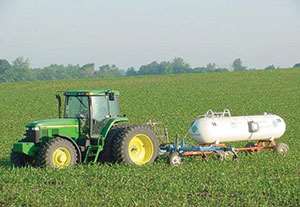By David Peters
It’s no secret that the farm economy has faced a downturn since its peak in 2012. But how has the downturn affected farmers, specifically related to their farm income and levels of farm debt?

A new study by David Peters, associate professor and extension rural sociologist with Iowa State University, aims to directly answer those questions. "Income Trends for Iowa Farms and Farm Families 2003-2015" (SOC 3076) is now available through the Extension Store.
“Family farm income has remained relatively high, even though there were strong declines in income across the board over the last three years,” Peters said. “That indicates the incomes in 2011 and 2012 must have been phenomenally high to keep income averages this high after a drop off, in many cases, of 30 to even 50 percent over the last two years.”
Commercial farm net income averaged $187,000 in 2015, down from a high of $381,344 in 2012. Intermediate farms, farms where the operator’s primary occupation is farming, averaged an income of $34,000. Residence farms, where the operator’s primary occupation is not farming, had an income of $17,000.
“The concern should be for the 800 to 1,000 acre commercial farm,” Peters said. “We talk in general about the falling farm economy, but the area of most concern is the midsized commercial farm. They are the leaders in rural communities and are the slice of the farm sector that policy makers should be most concerned about.”
The uniqueness of these farms – large enough to sustain a family but not so large as to be able to survive downturns in the economy – place them in a vulnerable position.
“Very large farms bring in a lot of income, there is more room for them to move as the economy goes up or down. And smaller farms survive on off-farm work,” Peters said. “With the midsized commercial class, policy should be aimed at supporting them, the ones with viable farm operations who are the most vulnerable to changes in the farm economy. They are the leaders in rural communities and we don’t want to lose them.”
Growing debt has become a problem for farms of this size. The debt utilization rate (a measure of total debt relative to maximum feasible debt) rose from 35 percent in 2012 to 73 percent in these farms three years later.
“Midsized farms have taken out as much debt as they feasibly can,” Peters said. “When we lump them together with larger farms the outlook is very rosy, but these midsized farms are the ones that are really struggling. Bringing home only around $100,000 a year with high debt levels makes them the most susceptible to any additional downturns in the economy.”
To Peters, the study clarifies the need for financially supporting farmers.
“It is so important to have farm bill income support for farmers,” Peters said. “This is exactly what those farm bill programs are designed to do; when there are short-term fluctuations in the economy they won’t drive people out of farming because they can’t afford it.”
Source:iastate.edu